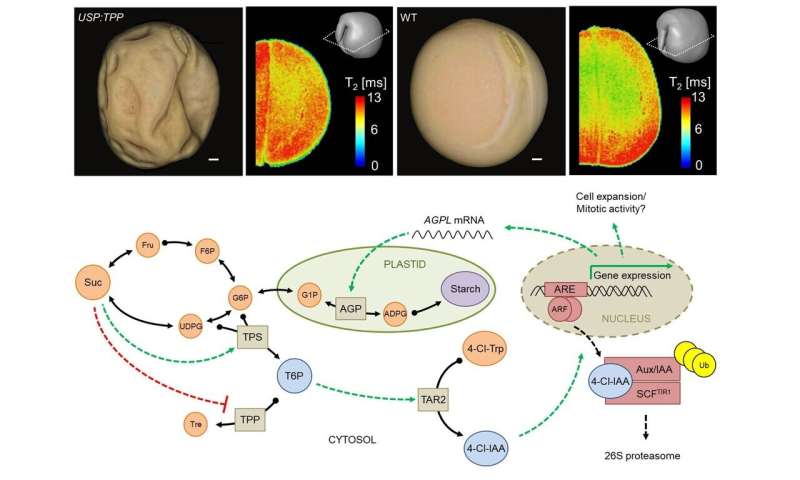Upper panel: The wrinkled seed phenotype and NMR* images of intact embryos with reduced T6P content (left) versus wild type (right). Relaxation time (T2) values are color?coded to visualize gradient within the embryo tissues. The miniature 3D-scheme indicates the virtual cross?section plane used for visualization of cotyledons. Lower panel: A simplified model of the T6P-auxin signaling pathway regulating embryo maturation in pea; details are further explained in the manuscript. Credit: IPK/ Meitzel
Plants undergo several developmental transitions during their life cycle. The differentiation of the young embryo from a meristem like structure into a highly specialized storage organ, is believed to be controlled by local connections between sugars and hormonal response systems. By modulating the trehalose 6-phosphate (T6P) content in growing embryos of pea (Pisum sativum), an international research team led by the Leibniz Institute of Plant Genetics and Crop Plant Research (IPK) investigated the role of this signaling sugar during the seed-filling process.
Efficient deposition of storage compounds in seeds is a key determinant of crop yield, but the underlying regulatory network of seed filling remains undefined. For many years, researchers have been working on the role of sugars for spatial regulation of seed growth and storage. In addition to their role as a carbon source for starch and protein biosynthesis, sugar molecules have important signaling functions. Numerous studies on the model plant Arabidopsis suggested that the signaling sugar trehalose 6-phosphate (T6P) forms an essential part of a signaling network regulating plant performance in general. The small size of Arabidopsis seeds, however, presents practical difficulties in investigating how T6P participates precisely in the regulation of seed filling. Therefore, the researchers made use of the larger size of pea seeds, allowing an easy preparation and compositional analysis of individual embryos. Their results have recently been published in the magazine New Phytologist.
"Our work identified T6P as a key regulator of seed filling in the grain legume pea and highlighted a link between T6P and the major plant hormone auxin," says Dr. Tobias Meitzel, researcher at IPK and first-author of the study. "This discovery represents a significant step forward in understanding interactions between metabolites and hormones with T6P reporting the raising sucrose status in the maturing seed. As a result of this, T6P mediates the activation auxin biosynthesis, which leads to a stimulation of embryo growth and reserve starch accumulation."
To better understand how T6P controls seed filling, researchers engineered transgenic pea plants aiming on the embryo-specific modulation of T6P levels. An impressive outcome of the targeted reduction of embryonic T6P content was a strongly wrinkled seed phenotype similar to that studied by Gregor Mendel in the mid term of the nineteenth century. "Nuclear magnetic resonance imaging of these embryos revealed a substantial impairment in the formation of a spatial gradient in storage product accumulation and tissue differentiation of embryos," says Dr. Ljudmilla Borisjuk, head of the research group Assimilate Allocation and NMR at IPK. "These findings explain many of the observations we already made two decades ago, when we first described the wave-like differentiation pattern of storing legume embryos."
This study is also of interest for various other areas of plant research as our findings identified T6P as an upstream regulator of auxin biosynthesis. "This hitherto unknown interaction between T6P and auxin might play a general role in mediating the sugar-auxin link," says Dr. Tobias Meitzel. It will be of ongoing interest to determine how this relationship fits within the current understanding of the regulatory frameworks surrounding growth processes and developmental transitions in plants.
More information: Tobias Meitzel et al, Trehalose 6‐phosphate promotes seed filling by activating auxin biosynthesis, New Phytologist (2020). DOI: 10.1111/nph.16956
Journal information: New Phytologist
Provided by Leibniz Institute of Plant Genetics and Crop Plant Research
























